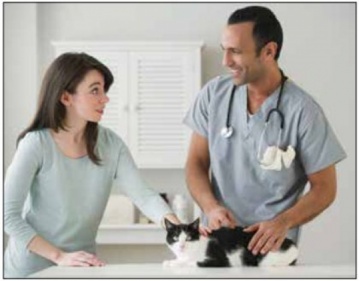
Just like humans need to see the doctor, cats need to see the veterinarian at least yearly, though some need to be seen more frequently. Even so, more than 50% of cats don’t receive veterinary care on a regular basis, according to the American Association of Feline Practitioners.
Cats are stoic animals, so it can be difficult to tell when they’re not feeling well, which is why Royal Canin created the “Take Your Cat to the Vet” campaign to spread awareness about the importance of preventative feline veterinary care.
While each annual appointment may look similar, your veterinarian is monitoring for different health concerns, such as kidney disease, depending on your cat’s life stage. During a typical physical examination, your vet assesses vital signs, including temperature, heart rate and respiratory rate, as well as your cat’s teeth and mouth, as tartar builds up and periodontal disease is common as cats age. Other areas your vet will check include ears and eyes, lymph nodes, skin and coat, weight, muscles, bones and joints.
As your cat ages, your vet will focus on specific developmental and health considerations.
Kittens (3 months-1 year): This is a highly active stage of life and you can expect curiosity and playfulness. It’s the time to socialize and bond with your cat, as well as get him or her accustomed to regular health practices like trimming nails and getting in the carrier. Your vet will monitor growth and development, offer advice to ensure your kitten is getting adequate nutrition, and educate you about breed-specific conditions or genetic concerns, along with disease prevention and options for spaying and neutering.
Young Adults (1-6 years): At this stage, you should be familiar with your cat’s normal behaviors and able to spot changes. Let your veterinarian know about any unusual signs like vomiting, excessive hairballs, or other behavior or grooming changes. Nutrition and weight management are increasingly important during this stage since preventing or managing obesity can help keep your cat healthier in its later years. Your vet will give extra attention to vital organs like the heart and lungs, as well as the skin and teeth.
Mature Adults (7-10 years): At seven years and older, many cats still look youthful and remain playful. However, there is an increased risk of age-related problems like diabetes, kidney disease, hyperthyroidism and cancer. Watch for common signs of disease in older cats such as poor coat condition, lethargy, weight loss, vomiting, diarrhea, constipation, change in appetite or reduced activity. During your annual checkup, your vet will likely pay extra attention to the abdomen, thyroid and kidneys, as well as assessing your cat’s muscle tone, bone structure and signs of arthritis or other pain.
Seniors (10 years and older): Cats need careful attention as they age, as many health problems can emerge simultaneously. If you notice signs or changes, avoid chalking them up to age and consult your veterinarian.
One common concern for senior cats is chronic kidney disease, which affects 30-40 percent of cats over the age of 10, according to research published in the “Compendium on Continuing Education for the Practicing Veterinarian.” Kidneys regulate the normal balance of fluid and minerals within your pet’s body and remove waste substances from the blood. Look for warning signs of kidney disease like increased thirst and urination, poor appetite, weight loss, vomiting, and poor hair or coat quality.
Find more advice to keep your cat’s health on track at RoyalCanin.com and join the conversation on social media using #Cat2Vet.
